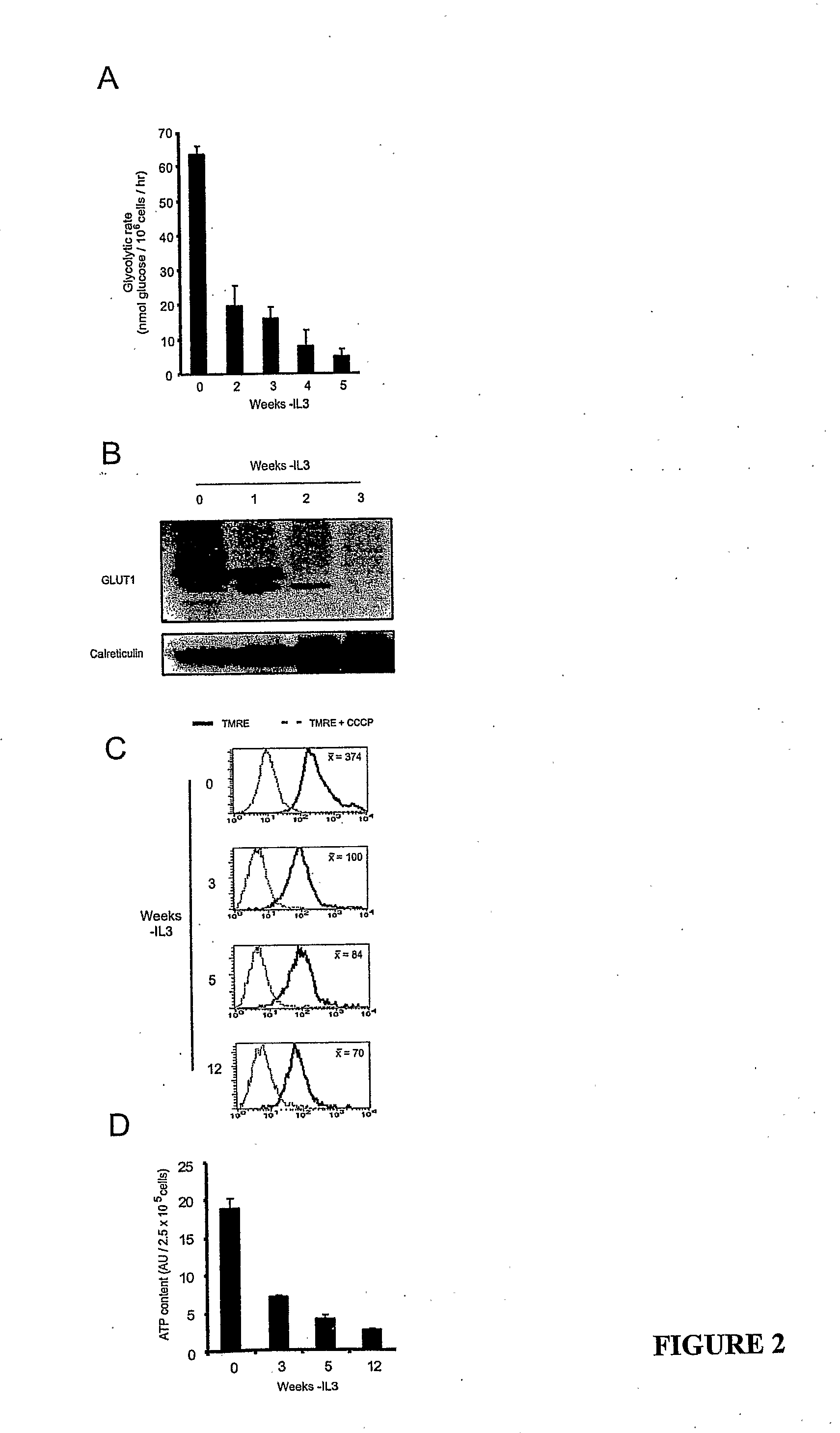Regulation of Autophagy and Cell Survival
a cell survival and autophagy technology, applied in the field of autophagy and cell survival regulation, can solve the problems of autophagy being reported to initiate cell death, recurrence of cancer following chemotherapy in some patients, and inhibiting cell death cells
- Summary
- Abstract
- Description
- Claims
- Application Information
AI Technical Summary
Benefits of technology
Problems solved by technology
Method used
Image
Examples
example 1
Summary
[0077]In animals, cells are dependent on extracellular signals to prevent apoptosis. However, using growth factor-dependent cells from Bax / Bak-deficient mice, we demonstrate that apoptosis is not essential to limit cell autonomous survival. Following growth factor withdrawal, Bax− / −Bak− / − cells activate autophagy, undergo progressive atrophy, and ultimately succumb to death. These effects result from loss of the ability to take up sufficient nutrients to maintain cellular bioenergetics. Despite abundant extracellular nutrients, growth factor-deprived cells maintain ATP production from catabolism of intracellular substrates through autophagy. Autophagy is essential for maintaining cell survival following growth factor withdrawal and can sustain viability for several weeks. During this time, cells respond to growth factor readdition by rapid restoration of the ability to take up and metabolize glucose and by subsequent recovery of their original size and proliferative potential...
example 2
[0105]Suitable pharmaceutical carriers are described in the most recent edition of Remington's Pharmaceutical Sciences, A. Osol, a standard reference text in this field.
[0106]Administering the pharmaceutical composition can be effected or performed using any of the various methods known to those skilled in the art. Systemic formulations include those designed for administration by injection, e.g. subcutaneous, intravenous, intramuscular, intrathecal or intraperitoneal injection, as well as those designed for transdermal, transmucosal, oral or pulmonary administration.
[0107]For injection, the compounds of the invention may be formulated in aqueous solutions, preferably in physiologically compatible buffers such as Hanks's solution, Ringer's solution, or physiological saline buffer. The solution may contain formulatory agents such as suspending, stabilizing and / or dispersing agents. Injectables are sterile and pyrogen free. Alternatively, the compounds may be in powder form for consti...
example 3
[0120]The National Cancer Institute alphabetical list of cancer includes: Acute Lymphoblastic Leukemia, Adult; Acute Lymphoblastic Leukemia, Childhood; Acute Myeloid Leukemia, Adult; Adrenocortical Carcinoma; Adrenocortical Carcinoma, Childhood; AIDS-Related Lymphoma; AIDS-Related Malignancies; Anal Cancer; Astrocytoma, Childhood Cerebellar; Astrocytoma, Childhood Cerebral; Bile Duct Cancer, Extrahepatic; Bladder Cancer; Bladder Cancer, Childhood; Bone Cancer, Osteosarcoma / Malignant Fibrous Histiocytoma; Brain Stem Glioma, Childhood; Brain Tumor, Adult; Brain Tumor, Brain Stem Glioma, Childhood; Brain Tumor, Cerebellar Astrocytoma, Childhood; Brain Tumor, Cerebral Astrocytoma / Malignant Glioma, Childhood; Brain Tumor, Ependymoma, Childhood; Brain Tumor, Medulloblastoma, Childhood; Brain Tumor, Supratentorial Primitive Neuroectodermal Tumors, Childhood; Brain Tumor, Visual Pathway and Hypothalamic Glioma, Childhood; Brain Tumor, Childhood (Other); Breast Cancer; Breast Cancer and Preg...
PUM
| Property | Measurement | Unit |
|---|---|---|
| time | aaaaa | aaaaa |
| volumes | aaaaa | aaaaa |
| concentration | aaaaa | aaaaa |
Abstract
Description
Claims
Application Information
 Login to View More
Login to View More - R&D
- Intellectual Property
- Life Sciences
- Materials
- Tech Scout
- Unparalleled Data Quality
- Higher Quality Content
- 60% Fewer Hallucinations
Browse by: Latest US Patents, China's latest patents, Technical Efficacy Thesaurus, Application Domain, Technology Topic, Popular Technical Reports.
© 2025 PatSnap. All rights reserved.Legal|Privacy policy|Modern Slavery Act Transparency Statement|Sitemap|About US| Contact US: help@patsnap.com



